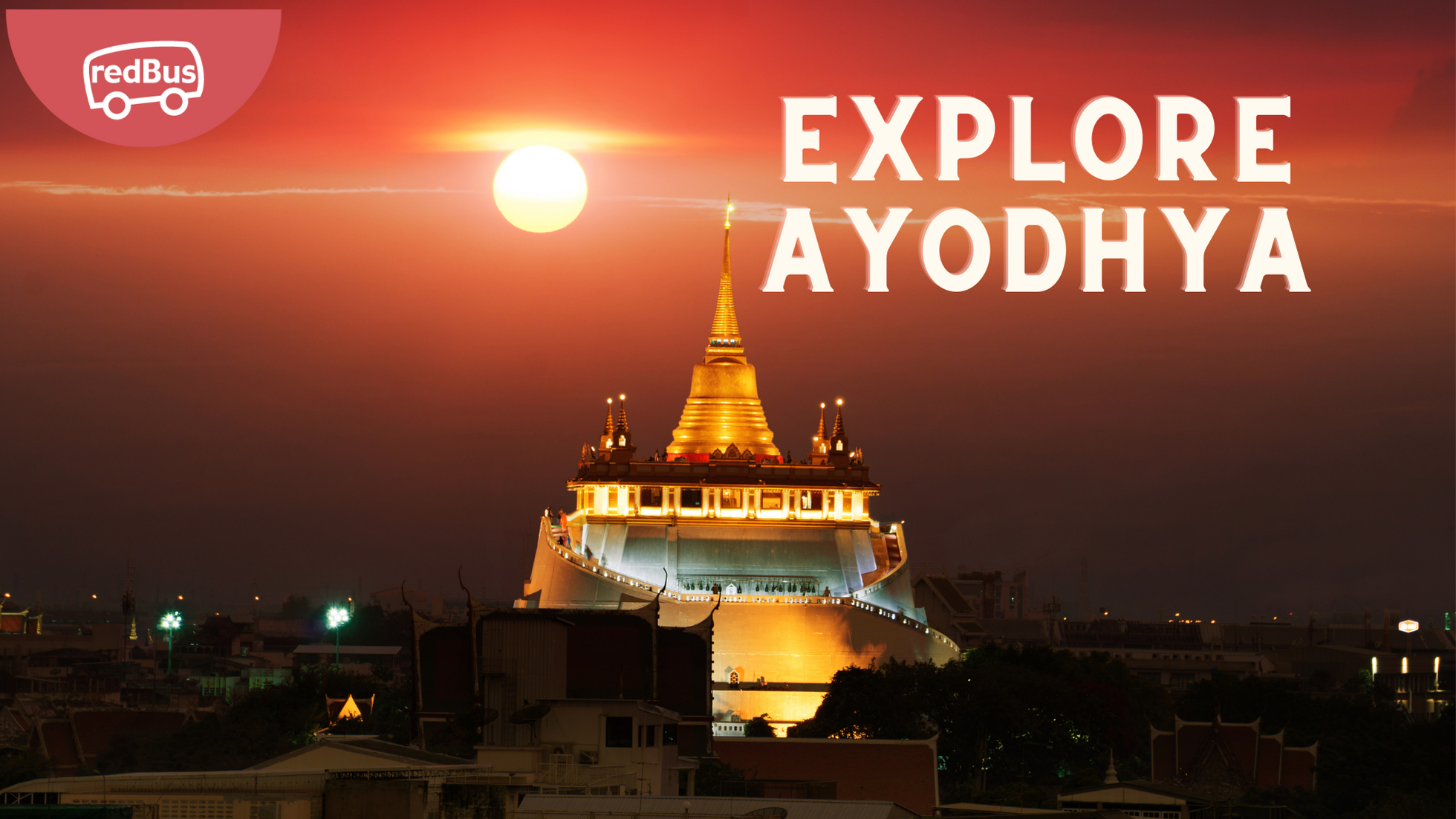Ayodhya, a city that resonates with echoes of ancient legends and historical significance, stands as a testament to India’s rich cultural heritage. Nestled on the banks of the sacred Sarayu River in the northern Indian state of Uttar Pradesh, Ayodhya is revered for its spiritual sanctity and cultural prominence. With a history that spans thousands of years, the city draws pilgrims, historians, and curious travelers alike. In this blog, we will embark on a virtual journey to explore the famous places that make Ayodhya a treasure trove of mythology and heritage.
Famous Places to Visit in Ayodhya
1. Ram Janmabhoomi:
The heart of Ayodhya, Ram Janmabhoomi, is the birthplace of Lord Rama, a central figure in the Indian epic Ramayana. The Ram Janmabhoomi complex houses the revered Ram Janmabhoomi Temple, which is believed to stand at the spot where Lord Rama was born. Pilgrims from across the globe visit this sacred site to offer their prayers and witness the architectural splendor of the temple.
2. Hanuman Garhi:
Perched atop a mound and surrounded by steep steps, Hanuman Garhi is a temple dedicated to Lord Hanuman. The temple is a significant pilgrimage site, and its location is believed to be the spot where Hanuman resided while guarding the Ram Janmabhoomi. The temple’s architecture and the panoramic views it offers make it a must-visit destination in Ayodhya.
3. Kanak Bhawan:
Kanak Bhawan, also known as Sone-ka-Ghar, is a beautiful temple dedicated to Lord Rama and his consort Sita. According to legend, it is said that Sita received this palace as a wedding gift from her mother. The temple is adorned with intricate carvings and paintings, depicting scenes from the Ramayana. Pilgrims visit Kanak Bhawan to seek the blessings of Lord Rama and Sita.
4. Treta Ke Thakur:
Treta Ke Thakur, also known as Raja Mandir, is an ancient temple dedicated to Lord Rama. The temple’s name translates to “Deity of the Treta Yuga,” signifying its historical and religious importance. The architecture and sanctity of Treta Ke Thakur make it a tranquil spot for devotees seeking a spiritual retreat.
5. Swarg Dwar:
Swarg Dwar, meaning the “Gate to Heaven,” is a prominent landmark in Ayodhya. According to Hindu mythology, it is believed that Lord Rama ascended to heaven from this spot. Pilgrims and visitors come to Swarg Dwar to pay their respects and witness the religious fervor that surrounds this celestial gateway.
6. Nageshwarnath Temple:
Dedicated to Lord Shiva, the Nageshwarnath Temple is one of the oldest temples in Ayodhya. The temple complex includes shrines dedicated to various deities, making it a place of religious diversity. The serene ambiance and ancient architecture of Nageshwarnath Temple attract devotees and history enthusiasts alike.
7. Kushadhwaja Maharaj Ashram:
Kushadhwaja Maharaj Ashram is associated with Lord Rama’s younger brother, Kushadhwaja. Legend has it that Kushadhwaja was a devout follower of Lord Shiva, and the ashram is believed to be his residence. Pilgrims visit this serene ashram to experience the tranquility and connect with the spiritual essence of Ayodhya.
8. Lakshmana Ghat:
The ghats along the Sarayu River hold immense religious significance in Ayodhya. Lakshmana Ghat is named after Lord Rama’s brother, Lakshmana. Pilgrims gather here for ceremonial rituals and take holy dips in the sacred river. The ghat comes alive during festivals and religious events, creating a vibrant atmosphere.
9. Mani Parbat and Sugriv Parbat:
Mani Parbat and Sugriv Parbat are two hillocks that are believed to have been brought by Hanuman from the Himalayas during the construction of the Ram Setu bridge. These hillocks offer panoramic views of Ayodhya and are dotted with small temples dedicated to various deities.
10. Tulsi Smarak Bhawan:
Ayodhya is also the birthplace of the revered poet-saint Tulsidas, who wrote the epic Ramcharitmanas. Tulsi Smarak Bhawan is a museum and memorial dedicated to Tulsidas, showcasing his life, works, and the cultural impact of Ramcharitmanas. Visitors can explore the artifacts and manuscripts related to Tulsidas and gain insights into the cultural and literary heritage of Ayodhya.
11. Guptar Ghat:
Guptar Ghat is believed to be the spot where Lord Rama took Jal Samadhi, a symbolic return to the elements, before ending his earthly sojourn. Pilgrims visit this ghat to perform rituals and pay homage to Lord Rama’s departure from the mortal realm.
12. Shringi Rishi Ashram:
Shringi Rishi Ashram is associated with the sage Shringi, who played a significant role in the Ramayana. The ashram is a peaceful retreat, and devotees visit to seek blessings and experience the spiritual energy of this ancient hermitage.
13. Ayodhya Research Institute:
For history enthusiasts, the Ayodhya Research Institute is a valuable destination. The institute houses a collection of ancient manuscripts, artifacts, and archaeological findings related to Ayodhya’s history. Visitors can delve into the city’s past and gain a deeper understanding of its cultural evolution.
14. Sita Ki Rasoi:
Sita Ki Rasoi, meaning “Sita’s Kitchen,” is a revered site where Sita is believed to have cooked for Lord Rama. The spot is marked by a symbolic kitchen, and pilgrims come to witness the divine significance of this humble yet spiritually charged place.
15. Ram Katha Park:
Ram Katha Park is a beautifully landscaped garden that narrates the story of Lord Rama through sculptures and installations. The park is an immersive experience, offering a visual journey through the epic Ramayana. It serves as a cultural and educational hub for both locals and tourists.
16. Ram Van Gaman Marg:
The Ram Van Gaman Marg is a path believed to trace Lord Rama’s journey into exile. This sacred route is dotted with temples, ghats, and historical landmarks, allowing pilgrims to retrace the footsteps of the legendary king.
17. Chakravarti Mahraj Dashrath Mahal:
Dedicated to King Dashrath, the father of Lord Rama, this mahal (palace) pays homage to the revered king. Visitors can explore the palace, which showcases artifacts related to King Dashrath’s reign and his role in the Ramayana.
18. Shri Raja Mandir:
Shri Raja Mandir is a temple dedicated to Lord Rama and his brothers, Lakshmana, Bharata, and Shatrughna. The temple’s architecture and vibrant spiritual ambiance make it a serene spot for devotees.
19. Treta Ke Ram Temple:
Treta Ke Ram Temple, as the name suggests, is dedicated to Lord Rama and is associated with the Treta Yuga. The temple’s intricate carvings and religious significance make it a must-visit destination for those seeking a deeper connection with Ayodhya’s spiritual legacy.
Ayodhya News Updates
Last update on 09-01-2024
UP Government is all set to Launch electric buses:
Get ready for an electrifying change in Ayodhya! The Uttar Pradesh government is gearing up to roll out electric buses on the Dharma Path and Ram Path, anticipating a surge in tourists and pilgrims flocking to the Ram Temple. Brace yourselves for a green revolution as a fleet of 100 electric buses hits the roads starting January 15!
Dedicated Coridore with Additional Parking space
The Uttar Pradesh Chief Minister’s Office (CMO) spilled the beans, sharing that they’ve constructed dedicated corridors and even secured additional parking spaces. From the crucial Saket Petrol Pump to Lata Mangeshkar Chowk, a range of parking facilities, both temporary and permanent, are in the works. It’s all part of the grand plan to ensure seamless travel and efficient crowd management for darshan and worship activities.
Ayodhya Consecration Ceremony of Lord Ram in Mrigashira Nakshatra
But that’s not all – the excitement doesn’t stop there. On January 22, the consecration ceremony of Lord Ram in ‘Mrigashira Nakshatra’ will take Ayodhya by storm. Post this divine event, the CMO assured us that they’re not hitting the brakes. Instead, they’re revving up activities, focusing on crowd management, worship, and travel facilitation, along with swift development of temporary parking spaces.
If you’re planning to embark on the Chaudah Kosi and Panchkosi Parikrama routes, the Uttar Pradesh government has got you covered. New designated areas at Udaya Chowk, spanning a whopping 70 acres (10 acres, 35 acres, and 25 acres), are being transformed into state-of-the-art parking lots.
Ayodhya’s four main paths – Ram Path, Dharma Path, Bhakti Path, and Janmabhoomi Path – are set to witness this monumental change. Inspired by the concepts of the four Vedas and four eras, these paths are about to redefine your Ayodhya experience.
Additional Pitstops in Ayodhya
Adding to the excitement, Chief Minister Yogi Adityanath is making a pitstop in Ayodhya today. He’s all set to meet with Ram temple trust officials and seers to fine-tune preparations for the grand consecration ceremony on January 22. The CM’s itinerary includes inspections of water works at Amani Ganj, the police control room, and the tent cities sprouting up courtesy of the Ayodhya Municipal Corporation. In the afternoon, he’ll be exploring exhibitions organized by the forest and urban development departments at the Circuit House.
And hold your breath for Wednesday, as the Bharatiya Janata Party (BJP) convenes to review the ongoing preparations for the much-anticipated ceremony. Brace yourself for an Amrit Mahotsav from January 14 to January 22, as Ayodhya gears up for an unforgettable celebration!
Ayodhya Special Buses from Noida
Plans are in progress to launch direct bus services from Noida to Ayodhya in anticipation of a large crowd during and after the inauguration of the Ram temple. The Uttar Pradesh State Road Transport Corporation (UPSRTC) will soon introduce these direct routes, addressing the absence of such services currently available. NP Singh, the assistant regional manager of UPSRTC Noida, highlighted the challenge of long-distance travel for CNG buses due to their limited range of 500 km on a full tank. To overcome this, a route plan has been developed, considering the bus range, and a CNG filling facility will be set up in Lucknow to cover the approximately 650 km distance effectively.
Conclusion:
Ayodhya, a city that breathes with the spirit of mythology and heritage, invites visitors to explore its sacred sites, historical landmarks, and cultural treasures. From the revered Ram Janmabhoomi to the tranquil ghats along the Sarayu River, Ayodhya weaves together a narrative that transcends time. As you step into this sacred city, you are not just a traveler; you become a part of a timeless tale that continues to unfold in the heartland of Uttar Pradesh. Ayodhya, with its divine aura and historical grandeur, stands as a testament to the enduring legacy of India’s cultural and spiritual heritage.







